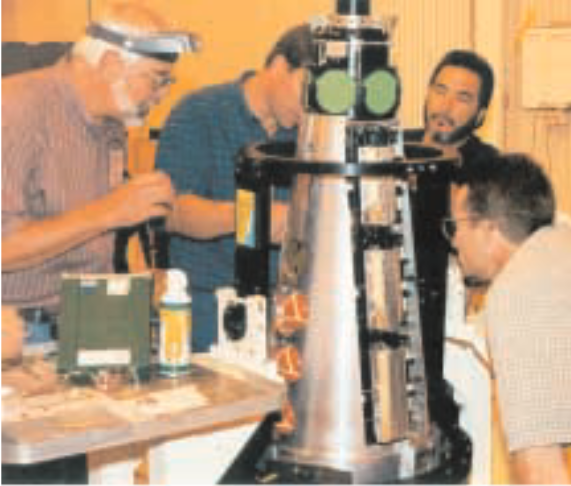Labs engineers, together with the US Army Space and Missile Defense Command, helped the Ballistic Missile Defense Organization (BMDO) test the limits of a national missile defense radar in September by dispersing into space an array of small objects that to the radar looked something like reentry vehicles (RVs) and deployment debris heading toward Earth.“Our role was to throw out a lot of interesting stuff for the radar to look at,” says Sandia mission project manager Dan Talbert of Targets Dept.15415.The Sept. 28 flight was the second in a series of RCT (Radar-Credible Targets) tests meant to examine the capabilities of the BMDO’s most advanced X-band radar, called the Ground-Based Radar Prototype (GBR-P). The GBR-P watched Sandia’s carefully orchestrated show from Kwajalein Atoll in the Pacific.
Making a scene
A Minuteman III missile launched from Vandenberg Air Force Base carried an RV-like plat-form, called a target deployment structure (TDS),that was specially created by Sandia to disperse a grouping of targets into the night sky. During the flight, six hockey-puck-shaped objects and six croquet-ball-like objects ejected from the TDS, along with six beach ball-sized balloons and one small rigid lightweight replica —essentially a five-foot-high cone that served as an RV surrogate for the mission.Many of the 20 objects mimicked the way areal RV might appear to the radar. The BMDO then used the GBR-P to assess the credibility of each target.“The RCT-2 target complex provided objects and spatial separations not heretofore available on [national missile defense] flight tests and hence an opportunity for testing GBR-P’s acquisition,wide-band tracking, and discrimination functions on a stressing target scene,”according to a BMDO test summary.“From a radar standpoint it was a totally successful mission,” says Dan.“Our customer was delighted.”
RCT-2 tests Sandia
To create the target scene the BMDO wanted, Labs propulsion experts built from scratch and tested a new type of solid-fuel thrust motor that spun the RV up to one rotation per second and then“de spun” it back to near zero, says Dan.“We went from pencil and paper to delivering a flight-certified spin system in eight months,” he says. “It was a small miracle we were able to develop and build the system on time and that it worked so well.”In fact, he says, everything Sandia put on the RV was developed specifically for the test except the rigid light replica. The pucks and balls had never been used before, and their ejection systems were newly designed and tested on the ground.

The balloon ejectors were also a new design for the RCT-2 mission. Sandia’s machine shops created the five-foot-tall TDS out of a solid chunk of aluminum that needed a lot of internal and external precision machining, Dan says. “We were able to go from the drawings straight to the shops,” he says. “We would not have been able to deliver without an in-house precision machining capability.”Core team members included lead technician Jimmy Aldaz (15413), lead mechanical engineer Robert Brown (15414), project engineer David Foral (15415), lead electrical engineer Martin Imbert (2663), lead mechanical designer Mel Krein (15415), mechanical designer Jacky Martinez (15415), electrical systems engineer C.R.N idever (ret.), mechanical technicians Brian Pardo (15413) and John Stanalonis (15417), electrical technician Doug Pastor (2663), and Dan.About 25 other people from Centers 2500,2600, 9100, 14100, and 15400 contributed.
KTF supports Jan. 25 Navy launch

Sandians at the Kauai Test Facility (KTF) successfully launched a target rocket Jan. 25as part of a flight test of an interceptor being developed for the Navy Theatre Wide missile defense system.The launch of the SM-3 interceptor from the Aegis cruiser USS Lake Erie several hundred miles northwest of Kauai was the interceptor system’s second test flight. The Jan. 25 test did not involve an actual intercept; its purpose was to evaluate the SM-3’s targeting system by collecting data as the interceptor approached and flew past the target vehicle launched from Kauai — in this case an Orbital Sciences Corp. Target Test Vehicle (TTV) based on a modified M56motor (Minuteman I second stage). A team of Sandians spent three weeks at Kauai helping Orbital prepare for the test.
During the launch they monitored and operated telemetry systems, countdown computers, tracking antenna, radar, and meteorological equipment. Two dry runs with mock target vehicles were conducted late last year in preparation for the launch. “Successful completion of this experiment was a critical early step in the development of Navy Theatre Wide ballistic missile defense,” says Dick Hay, Manager of Kauai Test Facility and Range Interface Dept. 15419. “The target vehicle, ship systems, and interceptor performed as anticipated, and our DoD customers were extremely happy with the results of the operation. ”Another Navy Theatre Wide target vehicle launch from Kauai is planned this spring. Sandians involved in the launch include Wilson Brooks, Hovey Corbin, Norm Corlis, Dick Hay, Diana Helgesen, Alonzo Lopez, Ed Mader, Dean Manning, Mark Montavon, Rod Stanopiewicz (all 15419), Eva Renninger (15414), Andy Jones (15417), Marc Kniskern,Walt Rutledge, Dave Salguero, and Larry Young(all 9115).

